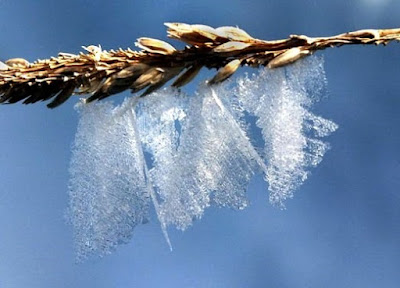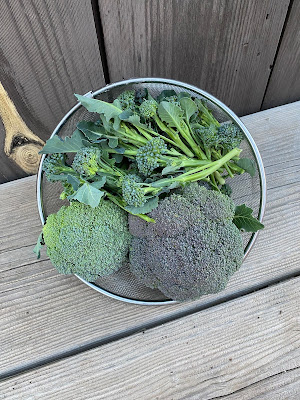Post by: Lisa Mason, Arapahoe County Extension
My colleagues and I hosted a plant and insect diagnostic
workshop in October, a collaboration with CSU Extension and the Plant Diagnostic
Clinic at the CSU Spur campus in Denver. About 45 Extension staff and Master
Gardener volunteers gathered to build relationships, and learn more about plant
pathology and insects. Even though I taught a portion of the workshop, I am always humbled
to remember the more I learn, the more I realize I don’t know. For instance, I
learned that we have a weedy species of bluegrass (Poa trivialis, rough bluegrass) that can be fairly common in lawns.
When the weather heats up, this type of bluegrass goes dormant. The grass turns
a slightly purple color before turning brown. This is a great reminder that it
is so important to know the plant identification before solving the problem.
Brown spots in lawns often are caused by gaps in the irrigation systems, but
it’s worth identifying the grass species to see if it could be rough bluegrass.
The solutions for irrigation gaps and removing a weedy species in the lawn are
entirely different. Overall, the biggest take-home message from the workshop
was a reminder to understand the big picture of the plant in the landscape before
making any judgements or diagnoses.
 |
| Diagnostic
workshop participants examine insects in the Orthoptera order (grasshoppers,
crickets, and katydids). Credit: Lisa Mason |
What exactly are
plant and insect diagnostics?
Extension offices around the state receive a broad spectrum
of questions at the Extension office varying in topic, need, and complexity. Some
examples of common questions include: How do I get a soil test? Is emerald ash
borer in my county? What plants do you recommend for low-water/xeriscape garden? Why do I
have brown spots in my lawn? Which disease does my tomato plant have? Why is my
tree struggling? Are insects harming my plant?
Plant
and insect diagnostics differ from many other questions because the plant needs
a diagnosis which requires understanding environmental context clues in
addition to the signs and symptoms present on the plant. While this might sound
easy, the process of diagnosing a plant issue can be very complicated! Consider
when you go to the doctor for a medical diagnosis for a persistent fever. A
wide variety of bacterial and viral infections, and other ailments could cause
a fever. A doctor will ask you questions to understand the bigger picture and
look for clues. Depending on the answers, the doctor may choose to run some
tests. Test results will further inform a diagnosis. Plant diagnostics is
similar. Perhaps you have a plant with brown leaves. Those brown leaves could
be a symptom from a number of environmental factors like drought stress or root
damage. Perhaps a bacterial, viral, or fungal pathogen is causing brown-colored
leaves. In some cases, maybe insects could be causing the damage to the plant.
 |
| Three
different causes of “brown leaves.” Left: Elm leafminer, a sawfly that feeds
within elm leaves creating brown patches. Center: fire blight, a contagious
bacterial disease affecting plants in the Rosaceae family. Right: Severe iron
chlorosis, an abotic or environmental condition where the plant can’t uptake
iron from the soil. Photos: Lisa Mason, William Jacobi, CSU, Bugwood.org, and
University of Illinois Plant Clinic. |
When you submit a plant or insect sample for diagnosis, be
prepared to answer questions! Here are some of the most common questions you’ll
be asked after you submit a plant sample:
- What do you need answered?
- Identification
- Diagnosis and management
recommendations
- Identification and control advice
- Other
- Do you have photos of the plant? Please submit photos up
close of the damage and also far away from the plant to see the entire plant in
the landscape?
- Do you know the identification of the plant?
- Where is the plant growing? (e.g. raised bed, next to the
house, in the lawn, etc.)
- How much water does the plant receive? How is the plant
watered?
- Do you apply any products (fertilizer, pesticides, etc.) to
the plant? What products and how often?
- Describe the issues and any observations you’ve noticed.
- What part of the plant is affected? (e.g. leaves, trunk,
branches, fruit, etc.)
- When did you first notice the issue? Are nearby plants
affected?
- Has anything changed in the environment recently?
A Master Gardener, CSU Extension staff, or Plant Clinic
staff will likely have additional questions depending on if the plant sample is
a tree, lawn, vegetable, other plant, or insect. All these questions help
inform the next steps for diagnosis and management recommendations.
Where do I submit
my plant sample?
You have options! CSU Extension and the Plant Diagnostic
Clinic partner together to ensure you get an accurate identification and/or
diagnosis. When you have a question, or when you bring in a plant or insect
sample to your
local county Extension office, we make sure to find the right expert to
identify and/or diagnose the issue. Depending on the nature of your question or
sample, your question may be answered by Master Gardeners, Extension staff or
specialists, or experts at the CSU Plant Diagnostic Clinic. Please note some
local counties may have a fee and the CSU Plant Diagnostic Clinic has sample
fee. Ask your local
county office if there is a fee. Click here for the CSU Plant
Diagnostic Clinic fees.
Learn more about
plant and insects
Land grant universities like Colorado State University have
a long history working on plant diagnostics (Iles
et al., 2021). If you are interested in learning more about nationwide
plant diagnostic efforts, check out the National
Plant Diagnostic Network.
Challenges with plants can often be avoided with the right
care practices. Learn more by taking classes through CSU Extension on variety
of topics related to plants, insects, gardening, and more! Check your local
county office, the free
webinars on the CO-Horts Blog, or Green
School which includes the Colorado
Master Gardener program.
What is CSU Spur?
Have you heard of the brand new CSU Spur campus? If not, you’ll want to learn
more! Spur is a brand new campus located within the National Western Center in
Denver. This campus is open to the public and is worth the visit to see the
state-of-the-art research and education facility from art installations, to
veterinary care, equine therapy, and more.
The CSU
Plant Diagnostic Clinic is now open at Spur! This is the Colorado state lab
in the National Plant Diagnostic Network. They offer services such as plant
disease diagnosis, insect identification, plant identification, and
recommendations.
The Soil,
Water, and Plant Testing Laboratory will also be opening at the Spur
campus. Stay tuned for their opening date.























